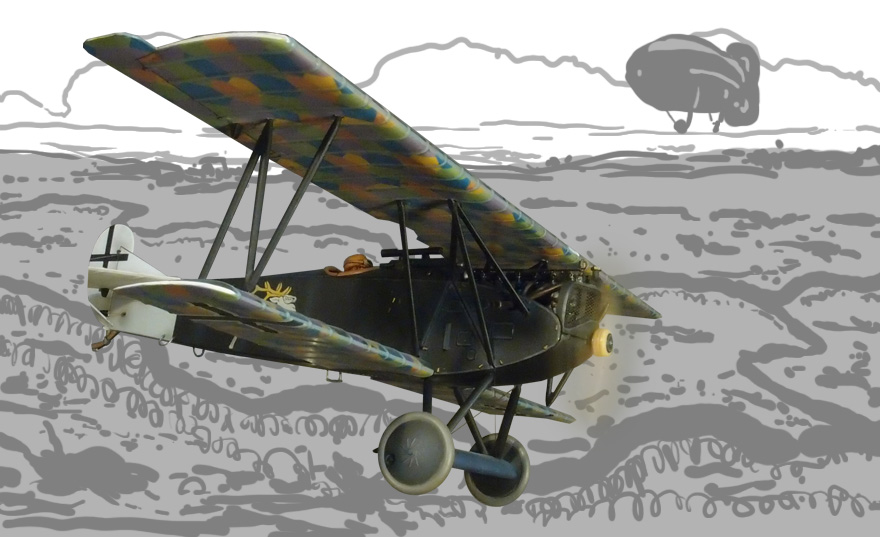With the White Stag Through Thick and Thin
John Jenkins Designs' planes are certainly amongst the best toy soldiers vehicles produced. They are rich in details and exceptionally well painted. The planes from the Knights Of The Skies collection are my favorite as they often have surprising color schemes and beautiful nose arts. One of the best looking pieces released so far is probably the JJ-ACE-37 - FOKKER DVII (Degelow); a plane flown by a very interesting pilot.
Carl Degelow was born in 1891 and served in both world wars. Prior to the Great War, he was working in the United States as an industrial chemist specialized in cement. When the conflict started, Degelow went back to Germany and enlisted in the infantry. His career as a pilot only started in 1916 when he got transferred to the air service. His first task was to work as an artillery spotter. It’s during this time that he shot down his first plane.
By mid 1917, Degelow was transferred to the fighter planes. He served in a few different squadrons and with different plane models. One of the most iconic of his planes was his late war black Fokker DVII with a white stag on the side. This is the model that John Jenkins had chosen to produce. Degelow ended the war with a total of 30 victories. He was also the last person to receive the Pour le Mérite award.

Carl Degelow and his plane.
Between the wars, Degelow remained in the reserve. In 1920, he got his memoirs published under the title “With the White Stag Through Thick and Thin”. When the Nazis took the power, he was arrested for not giving a proper nazi salute during a parade. He was released after several days when someone noticed the Pour le Mérite on his uniform. Before the war, Degelow tried to show the importance of jews in German aviation to protect them from the increasingly anti-semitic officers. When the Second World War started, he served once again to protect his country. During those terrible years, he used his position and connections to provide safe passage to former World War I German Jewish pilots. He ended the war with the rank of Major in the Luftwaffe.

Willi Rosenstein, one of the jewish pilots who was able to leave the Nazi Germany with the help of Degelow.
The model produced by John Jenkins is a Fokker D.VII and has wings covered with lozenge camouflage. This pattern is done on the model by what seems to be a large decal, probably because hand painting might not be good enough to reproduce such a repetitive pattern. One of the best looking features of this plane is the exposed engine. It is finely detailed and well visible behind a grid. Even if the plane is mostly black, a good weathering job was done. Oil leaks, dirt and rust can be seen everywhere on the plane.

The interior of the cockpit is also meticulously reproduced and outcompetes the work of many toy soldier manufacturers. Of course, there are also stags visible on each side of the plane. Those are beautiful art pieces and could be even considered quite fashionable by today’s standards.

By the way, Toy Soldiers Club is currently working on an exclusive clothing line. For now, two t-shirts are in preparation. Those are limited editions 100% made in Canada with designs inspired by the greatest aces in history. The two first releases are based on the nose art from the planes flown by Carl Degelow and Adolf Galland. Degelow’s fashionable deer is on a black t-shirt. On the shoulders, a WWI Balkenkreuz and an Fokker D.VII rudder can be seen. The price will be of 40$ US. We will let you know when those will be ready for pre-order!

As we can see, Degelow’s life was not an easy one, always trying to find a balance between flying and doing what he considers to be right, even if it requires taking risks to save jewish pilots. If you are curious to know more about Carl Degelow’s life, John Jenkins suggests reading “Black Fokker Leader” by Peter Kilduff. As for the plane model, it’s a beautiful and very fashionable piece that gets only more and more interesting as you learn about the life of the pilot behind the yoke. I now leave you with an appropriate movie suggestion with a lot of air battles and a quest to get a Pour le Mérite: The 1966 movie Blue Max directed by John Guillermin.

 Français
Français
